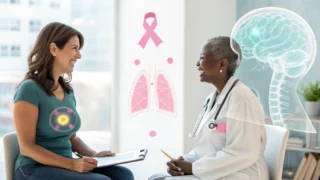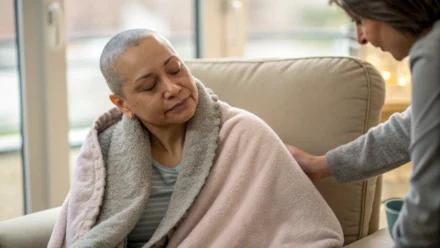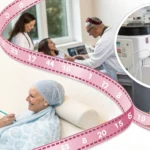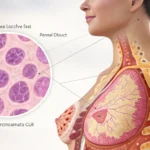This article summarizes a lesson I created for the Breast Cancer School for Patients. My goal is to explain, in clear and practical terms, what invasive breast cancer is, how it’s classified, what the actual threat to your life tends to be, how it’s treated and in what order, why tumor receptors matter, and when genetic (BRCA) testing should be considered. If you or someone you love has just received a diagnosis, this guide will help you ask the right questions and make informed decisions with your care team.
What is invasive breast cancer?
Invasive breast cancer refers to cancer cells that have developed the ability to grow beyond the part of the breast where they started and potentially spread to other parts of the body. This distinguishes it from non‑invasive conditions such as DCIS (ductal carcinoma in situ), which is more of a precancerous condition and makes up roughly 20% of what people call “breast cancer.” About 80% of breast cancers diagnosed are invasive.
Importantly: invasive cancers vary widely. Some grow slowly and are very treatable; others grow faster and need more aggressive therapy. The more you know about your particular tumor, the better you and your doctors can plan treatment.
Important facts and survival
- Treatments today can cure roughly 90% of people diagnosed with breast cancer.
- The majority of patients are diagnosed at an early stage, when outcomes are excellent.
- In most cases you have time to step back, learn, and make thoughtful decisions about surgery, chemotherapy, hormonal therapy, or radiation.
Five‑year overall survival for breast cancer as a group is around 89–90%. For very early stage disease (stage I) five‑year survival is typically in the 95–98% range. Stage IV (metastatic) disease carries a lower survival rate, but the precise outlook depends on many individual factors.
Remember: most people with newly diagnosed invasive breast cancer are diagnosed at an early stage and do very well.
Types of invasive breast cancer
There are several ways to describe breast cancer: by where the cells originated (ductal vs lobular), by how the cancer behaves (inflammatory, mucinous, etc.), and by tumor receptor status (ER, PR, HER2). Here are the most common categories:
Invasive ductal carcinoma (IDC)
IDC is the most common type — about 70% of invasive breast cancers. These cancers arise from the milk ducts and are treated similarly, in broad strokes, to invasive lobular carcinoma.
Invasive lobular carcinoma (ILC)
ILC makes up roughly 10–20% of invasive cancers. From a survival standpoint it is neither better nor worse than IDC, but it can have unique features that affect detection and treatment planning.
Inflammatory breast cancer
Inflammatory breast cancer is uncommon (about 5%) but aggressive. It can involve rapid breast enlargement, skin changes, and lymph node involvement and is treated very aggressively because it poses a significant threat.
Other less common types
Colloid (mucinous) and certain other subtypes are less aggressive and generally carry a lower risk, but they are less common overall.
Receptor types — why they are essential
Three tumor receptors guide much of modern breast cancer treatment: estrogen receptor (ER), progesterone receptor (PR), and HER2. Think of receptors as little switches on cancer cells that influence growth. The presence or absence of these receptors determines which treatments are likely to work.
- ER/PR positive: Tumors that express hormone receptors generally respond to hormonal (endocrine) therapies — drugs like tamoxifen or aromatase inhibitors — which block the hormone signals that fuel cancer growth.
- HER2 positive: HER2‑positive cancers (about 20–25%) are aggressive but highly treatable with targeted therapies (for example trastuzumab) combined with chemotherapy. These targeted therapies have dramatically improved outcomes for HER2‑positive patients.
- Triple negative: Tumors that lack ER, PR and HER2 (about 15%) tend to be more aggressive and generally require chemotherapy when the patient is fit enough to receive it.
Knowing your receptor status is one of the single most important pieces of information you’ll get from your pathology report. It directly influences whether you receive hormonal therapy, targeted therapy, chemotherapy, or a combination.
How invasive breast cancer is treated — typical timeline and decision points
Treatment pathways vary, but for the majority with early stage disease (about 70%) the usual sequence looks like this:
- Diagnosis by biopsy: A needle biopsy confirms invasive cancer and the pathologist reports tumor type and receptor status.
- Visit with a breast surgeon: Most patients have surgery first. The surgeon’s goals are to remove the tumor (lumpectomy) or the entire breast (mastectomy) and evaluate lymph nodes under the arm (sentinel node biopsy or node removal).
- Decision about systemic therapy (medical oncology): After surgical pathology, you’ll discuss with a medical oncologist whether you’ll benefit from chemotherapy, hormonal therapy, targeted therapy, or some combination. This decision is based on tumor size, lymph node status, receptor results, genomic assays in some cases, your overall health and personal preferences.
- Radiation oncology: If you keep your breast (lumpectomy), radiation to the whole breast is generally recommended. Radiation usually follows chemotherapy if chemo is given; if no chemo is needed, radiation comes after surgery and before longer‑term hormonal therapy.
- Long‑term endocrine therapy: For ER‑positive patients, hormonal therapy (often pills taken for years) reduces the chance of recurrence.
Note: In some situations — for example larger tumors or when we want to shrink cancer before surgery — chemotherapy is given first (neoadjuvant chemotherapy). Treatment planning should be individualized with your multidisciplinary team.
BRCA and genetic testing — who should consider it?
Most women with breast cancer do not carry a BRCA mutation. Roughly 85–90% of breast cancers are not due to BRCA or similar inherited mutations. Still, about 10–15% may be linked to inherited genetic changes, and identifying one has important implications for future cancer risk and management.
When to consider genetic testing:
- Young age at diagnosis (for example, breast cancer in your 30s).
- A personal or family history of early‑onset breast cancer, ovarian cancer, multiple affected relatives, or known BRCA mutation in the family.
- Other risk factors that meet established testing guidelines discussed with your clinician.
If you carry a BRCA mutation you have a higher lifetime risk of developing a new breast cancer (if any breast tissue remains) and a significantly increased risk of ovarian cancer. For ovarian cancer risk, because screening is poor, we often recommend removing the ovaries (risk‑reducing salpingo‑oophorectomy) once childbearing is complete.
Talk with your physician or a genetic counselor to determine whether testing is appropriate for you.
Questions you should ask your breast cancer specialists
Being prepared for each visit helps you get clear, actionable answers. Here are key questions to bring to your appointments:
- What exactly is invasive breast cancer in my case?
- What type of breast cancer do I have (ductal, lobular, other)?
- What is the chance I will die from my breast cancer? (Ask about stage‑specific survival and what it means for you.)
- What are my receptor results (ER, PR, HER2)?
- May I have a copy of my pathology report?
- Do I qualify for genetic counseling and BRCA testing?
- What is the recommended sequence of treatments for my tumor?
Final thoughts — you’re not alone and knowledge matters
Invasive breast cancer is real and it can be serious, but treatment has advanced tremendously. Most people diagnosed today are found at an early stage and do very well. Your care is best guided by understanding the essential facts about your tumor: its type, size, lymph node status, and receptor profile. These details determine which treatments are likely to help you most.
If you want to learn more in an organized way, the Breast Cancer School for Patients provides structured lessons that explain each step — what to expect from imaging, surgery, medical oncology, radiation, pathology reports, tumor receptors and genetic testing — and a curated list of questions to bring to your next doctor’s visit. Register with the program to get those question lists and support to help you make informed decisions with your care team.
Knowledge is power: the more you understand about your specific breast cancer, the better you can work with your doctors to get the best possible care.











Leave a Comment